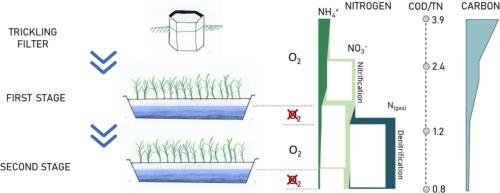好氧滴滤器与两级垂直流处理湿地相结合的系统的碳和氮去除性能
IF 3.9
2区 环境科学与生态学
Q1 ECOLOGY
引用次数: 0
摘要
湿地处理已成为废水处理,特别是农村地区生活或农业污水处理的一种参考方法。由 SCIRPE 公司开发的 AZOE 工艺是一种优化的水处理系统,它以垂直水流的传统两级处理湿地为基础。在系统的顶端增加了一个涓流过滤器,过滤级已部分饱和,以促进缺氧条件。本研究介绍了对一个完整的中试规模 AZOE 系统的监测情况,该系统接收真实和连续的污水。研究了一年中两个时期的污水:有机负荷较高的秋季和春季。本研究介绍了每个处理单元以及整个处理单元的性能。主要结果表明:i) 无论季节如何,滴滤器都会消耗约一半的碳负荷,但当流入的有机物负荷较高时,硝化作用较低 ii) 由于存在缺氧区,第一级过滤对反硝化作用很大 iii) 第二级过滤的作用较低,但在流入的有机物负荷较高时,其作用会增加,这凸显了该处理装置的安全作用。第一级和第二级出水口的连续氨氮和硝氮数据显示了该系统在进水期间的动态特征: 第一级出水口的硝氮峰值非常明显,而第二级出水口的硝氮峰值也非常明显。碳的缺乏被认为是第二阶段反硝化的最大限制因素。本文章由计算机程序翻译,如有差异,请以英文原文为准。

Performance of carbon and nitrogen removal in a system combining an aerobic trickling filter followed by two stages of vertical flow treatment wetland
Treatment wetland has become a reference in wastewater treatment, particularly for the treatment of domestic or agricultural effluent in rural areas. The AZOE process developed by the company SCIRPE is an optimised system of water treatment based on a conventional two-stage treatment wetlands with vertical hydraulic flow. A trickling filter has been added at the head of the system and filtration stages have been partially saturated to promote anoxic conditions. This study presents the monitoring of a complete pilot-scale AZOE system receiving real and continuous effluents. Effluents from two periods of the year are studied: autumn and spring when the organic load is higher. The performance of each treatment unit, as well as the total treatment unit is presented in this study. The main results show that i) the trickling filter consumes about half of the carbon load whatever the season but that nitrification is lower when the incoming organic load is higher ii) the first stage of filtration contributes a lot to denitrification thanks to the anoxic zones iii) the contribution of the second stage is lower but can increase in case of higher incoming load highlighting a safety role of the treatment. The continuous ammonium and nitrate data at the outlet of the first and second stages show a very characteristic dynamic of this system during the feeding period: a well-defined nitrate peak at the outlet of the first stage which is found on the second stage. The lack of carbon is pointed out as the most limiting factor to denitrification on the second stage.
求助全文
通过发布文献求助,成功后即可免费获取论文全文。
去求助
来源期刊

Ecological Engineering
环境科学-工程:环境
CiteScore
8.00
自引率
5.30%
发文量
293
审稿时长
57 days
期刊介绍:
Ecological engineering has been defined as the design of ecosystems for the mutual benefit of humans and nature. The journal is meant for ecologists who, because of their research interests or occupation, are involved in designing, monitoring, or restoring ecosystems, and can serve as a bridge between ecologists and engineers.
Specific topics covered in the journal include: habitat reconstruction; ecotechnology; synthetic ecology; bioengineering; restoration ecology; ecology conservation; ecosystem rehabilitation; stream and river restoration; reclamation ecology; non-renewable resource conservation. Descriptions of specific applications of ecological engineering are acceptable only when situated within context of adding novelty to current research and emphasizing ecosystem restoration. We do not accept purely descriptive reports on ecosystem structures (such as vegetation surveys), purely physical assessment of materials that can be used for ecological restoration, small-model studies carried out in the laboratory or greenhouse with artificial (waste)water or crop studies, or case studies on conventional wastewater treatment and eutrophication that do not offer an ecosystem restoration approach within the paper.
 求助内容:
求助内容: 应助结果提醒方式:
应助结果提醒方式:


